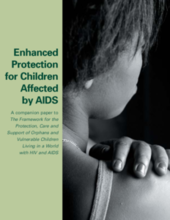The past six years have seen increasing engagement by the international community on HIV, AIDS and children. One of the eight Millennium Development Goals set by governments in 2000 relates directly to HIV and AIDS. In 2001, at the United Nations General Assembly Special Session on HIV/AIDS, governments pledged to protect children affected by the disease. Global commitment to combat the impact of HIV and AIDS on children was again outlined in 2002 in ‘A World Fit for Children’, the outcome document of the UN General Assembly Special Session on Children. More recently, in June 2006, the UN General Assembly adopted the Political Declaration on HIV/AIDS, which reiterated government commitment to “addressing as a priority the vulnerabilities faced by children affected by and living with HIV; providing support and rehabilitation to these children and their families, women and the elderly, particularly in their role as caregivers; promoting child-oriented HIV/AIDS policies and programmes and increased protection for children orphaned and affected by HIV/AIDS…and building, where needed, and supporting the social security systems that protect them.”
Many international and non-governmental organizations have endorsed The Framework for the Protection, Care and Support of Orphans and Vulnerable Children Living in a World with HIV and AIDS (The Framework), which outlines key strategies and actions. In October 2005, the Unite for Children. Unite against AIDS global campaign was launched. Among the central goals of the campaign is the protection, care and support of children affected by AIDS. Many countries heavily affected by the pandemic have responded by developing their own plans of action for orphans and vulnerable children, creating a mechanism for coordination and oversight for governments to work closely with civil society.
This companion paper to The Framework provides additional information and outlines recommended actions for protecting affected children from increased vulnerability, and for reducing the higher risks they face of abuse, exploitation and neglect. While this paper discusses the protection issues facing children globally, its actions speak directly to the findings of the publication, Africa’s Orphaned and Vulnerable Generations: Children affected by AIDS, which incorporates new research on the vulnerability of orphans in the region hit hardest by the pandemic.
All children have a right to protection. A child whose family is wealthy can still be raped or beaten. A girl in a loving family may still be married against her will when this is the social norm. Nevertheless, the risks for children increase when they or their families are poor, lack access to basic services, or are stigmatized within their communities. Parents are children’s first line of protection; risks increase when parents are absent due to illness, death or abandonment.
Children affected by AIDS are particularly vulnerable to protection violations because these problems are more likely to cluster in their lives. Reaching this group of children can be difficult because they may be hidden from view due to the stigma around HIV and AIDS. Children affected by AIDS share many vulnerabilities with children who have disabilities, children who are discriminated against due to the colour of their skin or children who have lost their parents as a result of armed conflict.
Protecting children affected by AIDS requires strengthening national and community-level responses for all vulnerable children. Governments, civil society and their partners can make real progress towards this goal by enhancing social protection, legal protection and justice and alternative care. This work must be underpinned by efforts to address the silence and stigma that allow both HIV- and AIDS-related discrimination, abuse and exploitation of children to continue. It also requires strengthening government authorities that hold the bulk of responsibility for protection, to more effectively provide oversight and coordination. This responsibility often falls to government social welfare agencies, but may also include health, education and other agencies.
©This companion paper was supported by CIDA, and endorsed by 28 organizations.

